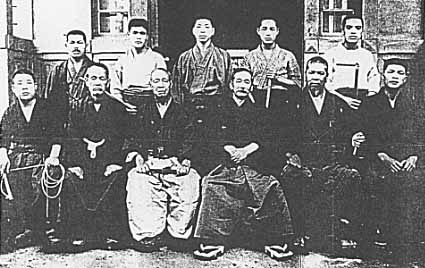by Neil Ohlenkamp
auf Deutsch
Judo is derived from Jujutsu. It was created by Professor Jigoro Kano who was born in Japan on October 28, 1860 and who died May 4, 1938 after a lifetime of promoting Judo. Mastering several styles of jujutsu including Kito-Ryu and Tenjin-shinyo Ryu in his youth he began to develop his own system based on modern sports principles. In 1882 he founded the Kodokan Judo Institute in Tokyo where he began teaching and which still is the international authority for Judo. The photo below shows Jigoro Kano with a gathering of jujutsu leaders in 1921.
 An early gathering of Judo and Jujutsu leaders — Jigoro Kano is seated third from the right |
The name Judo was chosen because it means the gentle or yielding way. Kano emphasized the larger educational value of training in attack and defense so that it could be a path or way of life that all people could participate in and benefit from. He eliminated some of the traditional jujutsu techniques and changed training methods so that most of the moves could be done with full force to create a decisive victory without injury. The popularity of Judo increased dramatically after a famous contest hosted by the Tokyo police in 1886 where the Judo team defeated the most well-known jujutsu school of the time. It then became a part of the Japanese physical education system and began its spread around the world.
The growth of Judo in its early years is demonstrated by the growth of the Kodokan itself:
- 12 mats (May 1882 Eishoji Temple)
- 10 mats (Feb. 1883 Jimocho, Kanda)
- 20 mats (Sept. 1883 Shihan's house, Kojimachi)
- 40 mats (Spring 1887 Mr. Shinagawa's house, Kojimachi)
- 60 mats (April 1890 Hongo-ku, Masaga-cho)
- 107 mats (Feb. 1894 Koishikawa-cho, Shimotomisaka-cho)
- 207 mats (Nov. 1897 Koishikawa, Shimotomisaka-cho)
- 314 mats (Jan. 1898 Otsuka Sakashita-cho)
- 514 mats (Dec. 1919 1-chome Kasuga-cho, Bunkyo-ku)
- 986 mats (March 1958 2-chome, Kasuga-cho, Bunko-ku)
Other aspects of Kodokan Judo were introduced over time such as the Kangeiko (winter training) in 1894, the Shochugeiko (summer training) in 1896, and the spring and autumn Red & White Contests which began in 1884. Today the Red and White tournament is the longest running competitive sporting event in the world. The Kodokan Judo Kata, the basic syllabus of techniques (Gokyo-no-waza), the Kodokan Cultural Society, and research components were also added.
In 1928, after attending the Olympic Games of Amsterdam, Jigoro Kano conceived the idea to get Judo in the Olympic Games. In 1936 in Berlin, during the 35th session of the International Olympic Committee, the XII Olympic Games were scheduled for 1940 in Tokyo, where Judo of course would be added, but the war against China in 1937 forced Japan to withdraw from the organization of these Games and Judo was included only as a demonstration. In 1964 men's Judo competition finally became a part of the Olympics, the first asian martial art as an official medal sport. In 1992 Judo competition for women was added to the Olympics.
Judo consists primarily of nage-waza (throws), along with katame-waza (grappling), which includes osaekomi-waza (pins), shime-waza (chokes), and kansetsu-waza (joint locks). Additional techniques, including atemi-waza (striking), various joint locks, self defense and weapons are found in the Judo katas. Judo is generally compared to wrestling, but it retains its unique combat forms. As a daughter to Jujutsu these techniques are also often taught in Judo classes. Because the founder was involved in education (President of Tokyo University) Judo training emphasizes mental, moral and character development as much as physical training. Most instructors stress the principles of Judo such as the principle of yielding to overcome greater strength or size, as well as the scientific principles of leverage, balance, efficiency, momentum and control. Seiryoku zenyo (maximum efficiency) and Jita kyoei (mutual welfare and benefit) are the best known of the principles of Judo. Judo is a good choice for most children to learn because it is safe and fun, and because it emphasizes education and proper development of the body, mind, and character.
Judo training has many forms for different interests. Some students train for competition by sparring and entering the many tournaments that are available. Other students study the traditional art and forms (kata) of Judo. Other students train for self-defense, and yet other students practice Judo for fun and recreation. Black belts are expected to learn all aspects of Judo.
Because Judo developed in modern times it is organized like other major sports with one international governing body for the sport, the International Judo Federation (IJF). The Kodokan continues to be the technical authority for the martial art of Judo. Unlike many other martial arts, Judo competition rules, training methods, and rank systems are relatively uniform throughout the world.
"The world is changing and Ju Jutsu has to change too. I don’t think it’s practical to limit ourselves to one particular style. I no longer see any point in keeping the techniques of each Ju Jutsu school a secret. It would be better to experiment with a whole range of techniques and select the ones you want to use, changing them if necessary. I’d like to take the best techniques from the Yoshin style and the best techniques from a lot of other styles and combine them all to create the ultimate form of Ju Jutsu. Last year after we performed for President Grant, Master Fukuda spoke of bringing Ju Jutsu to the rest of the world. To do that, we can’t rely on just one particular style – we need a combination of the best techniques from all the major schools of Ju Jutsu. That’s what I’d like to teach to the rest of the world." — Jigoro Kano, 1880
A man who has attained mastery of an art reveals it in his every action……Samurai maxim

